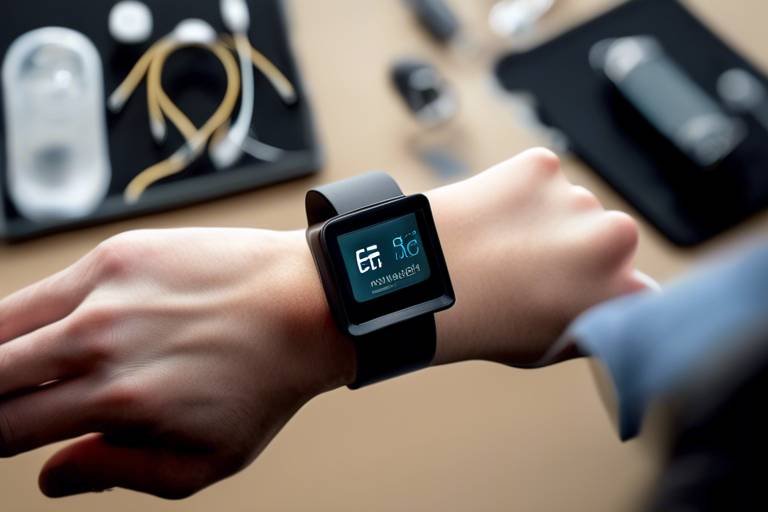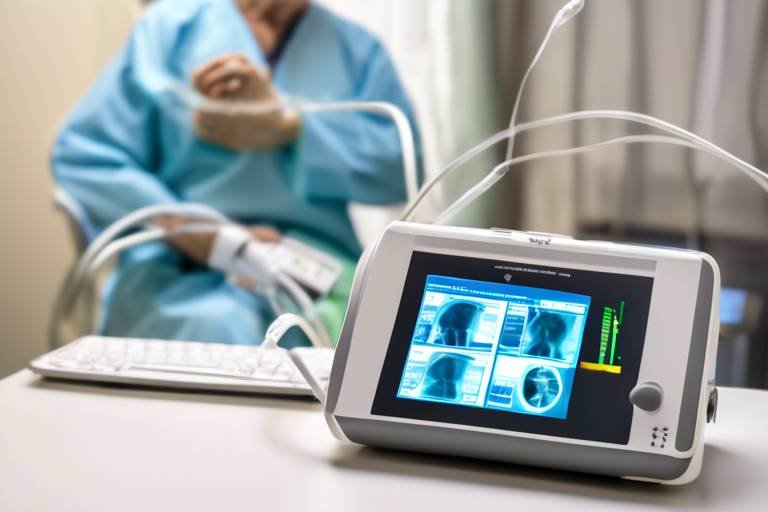Exploring Smart Wearables for Health Monitoring
In today's fast-paced world, the quest for better health often feels like a never-ending journey. However, with the advent of smart wearables, we now have a powerful ally in this pursuit. These innovative devices are not just trendy gadgets; they're transforming how we monitor and manage our health. Imagine having a personal health assistant right on your wrist, offering insights and real-time feedback about your body. It's like having a mini-doctor available 24/7, ready to provide valuable information at a moment's notice.
Smart wearables encompass a variety of devices, from fitness trackers to smartwatches, each equipped with advanced sensors and technology. Their primary function is to monitor various health metrics, including heart rate, sleep patterns, and physical activity levels. This constant stream of data allows users to make informed decisions about their health and well-being. But what exactly are these devices capable of? Let’s dive deeper into the world of smart wearables and explore their incredible potential.
Smart wearables come in various forms, each tailored to specific health monitoring needs. Some of the most common types include:
- Fitness Trackers: These devices primarily focus on tracking physical activity, steps taken, calories burned, and even heart rate.
- Smartwatches: Combining the functionality of a traditional watch with health tracking capabilities, smartwatches can monitor heart rate, sleep, and even provide notifications for calls and messages.
- Health Monitors: These specialized devices can track specific health metrics such as blood pressure, glucose levels, and more, catering primarily to individuals with chronic health conditions.
Each type of wearable serves a unique purpose, yet they all share the common goal of empowering users to take control of their health. With this technology, individuals can track their progress, set health goals, and receive personalized insights that can lead to improved health outcomes.
The benefits of health monitoring wearables are numerous and impactful. One of the most significant advantages is the ability to provide real-time data tracking. Imagine being able to see your heart rate fluctuate during a workout or monitor your sleep patterns over time. This immediate feedback allows users to make better health decisions. For instance, if you notice your heart rate spikes during exercise, you might adjust your intensity to avoid overexertion.
Real-time data tracking is a game-changer for health management. It gives users the power to observe their health metrics continuously, leading to informed decisions that can enhance their well-being. Whether you're a fitness enthusiast or someone managing a chronic condition, having access to this information at your fingertips can significantly impact your lifestyle choices.
Heart rate monitoring is a critical feature of many wearables. For fitness enthusiasts, tracking heart rate during workouts can help optimize performance and ensure safety. For individuals managing chronic conditions, such as heart disease, continuous monitoring can alert them to potential issues before they escalate. It’s like having a personal trainer and a doctor combined into one device, guiding you through your health journey.
Another fascinating aspect of smart wearables is their ability to track sleep patterns. Understanding your sleep quality can be a revelation. Many wearables provide insights into the different stages of sleep, helping users identify areas for improvement. Better sleep means better health, and these devices can guide users toward achieving a more restful night.
Moreover, wearables offer personalized health insights that help users understand their unique health patterns. This tailored approach enhances user engagement and motivation. For example, if a wearable detects that you’re not getting enough physical activity, it might recommend a daily step goal or suggest specific workouts based on your preferences. It’s like having a health coach who knows you personally and motivates you to stay on track.
Despite their many benefits, wearable technologies face challenges that need addressing for wider adoption. One significant concern is data privacy. As these devices collect sensitive health information, users must trust that their data is handled securely. The implications of data breaches can be severe, making it crucial for companies to prioritize user privacy and data protection.
Data privacy is not just a buzzword; it’s a legitimate concern for users of health monitoring wearables. With personal health data being collected and shared, users should be aware of how their information is used and stored. Companies must implement robust security measures to protect user data and build trust with their customers.
Another challenge is the accuracy and reliability of the health data collected by wearables. Not all devices are created equal, and the accuracy of metrics can vary significantly. Users rely on this data for making critical health decisions, so it’s essential to choose wearables that have been validated for their accuracy. After all, when it comes to health, every bit of information counts!
The future of smart wearables is bright and full of potential. As technology continues to advance, we can expect even more integration with healthcare systems, leading to a more holistic approach to health monitoring. Imagine wearables that can predict health issues before they arise or seamlessly share data with healthcare providers for real-time monitoring. The possibilities are endless, and the impact on personal healthcare could be revolutionary.
- What are smart wearables? Smart wearables are devices equipped with sensors and technology to monitor health metrics such as heart rate, sleep patterns, and physical activity.
- How do wearables improve health management? They provide real-time data tracking, personalized insights, and help users make informed health decisions.
- Are there privacy concerns with health wearables? Yes, data privacy is a significant concern, and users should ensure that their devices have robust security measures in place.
- Can wearables accurately track health data? While many wearables offer accurate data, the reliability can vary, so it's essential to choose devices that have been validated.

Understanding Smart Wearables
Smart wearables are revolutionizing the way we approach health and wellness. These devices, often worn on the wrist, chest, or even clothing, are equipped with advanced sensors and technology that continuously monitor various health metrics. Imagine having a personal health assistant that never takes a break! From tracking your heart rate to analyzing your sleep patterns, smart wearables are designed to provide a comprehensive view of your health in real-time.
There are several types of smart wearables available, each offering unique functionalities that cater to different health monitoring needs. For instance, fitness trackers are popular among those seeking to enhance their physical activity, while smartwatches often come with additional features such as notifications and apps. Here’s a quick overview of the main types of smart wearables:
| Type of Wearable | Primary Function |
|---|---|
| Fitness Trackers | Monitor physical activity, steps, and calories burned. |
| Smartwatches | Provide notifications, track fitness, and monitor health metrics. |
| Health Monitors | Focus on specific health metrics like heart rate and blood pressure. |
| Smart Clothing | Integrate sensors into fabrics to monitor various health and fitness metrics. |
The primary functions of these wearables extend beyond just counting steps or tracking workouts. They can monitor vital signs such as heart rate, respiratory rate, and even blood oxygen levels. This data is invaluable, especially for individuals managing chronic conditions or those who want to optimize their fitness routines. With the ability to sync with smartphones and other devices, users can easily access their health data and trends, making it simpler to stay informed and proactive about their health.
Moreover, the integration of artificial intelligence (AI) in smart wearables is transforming the landscape even further. AI algorithms can analyze the data collected and provide personalized insights, helping users make informed decisions about their health. For example, if a wearable detects irregular heart rates, it can alert the user to seek medical advice, potentially preventing serious health issues. This proactive approach to health monitoring is not just a trend; it’s becoming a necessity in our fast-paced lives.
In conclusion, understanding smart wearables is crucial in today’s health-conscious society. These devices are not just gadgets; they are powerful tools that empower individuals to take charge of their health. Whether you’re a fitness enthusiast or someone looking to improve your overall well-being, smart wearables can offer a plethora of benefits that can lead to healthier lifestyle choices. As technology continues to evolve, the potential for these devices to enhance personal healthcare is limitless.

Benefits of Health Monitoring Wearables
Health monitoring wearables have taken the wellness world by storm, and for good reason! These nifty gadgets are not just trendy accessories; they are powerful tools that can significantly enhance your health management. Imagine having a personal health assistant right on your wrist, constantly tracking your vital signs and providing insights tailored specifically for you. Sounds amazing, right? Well, let’s dive deeper into the myriad of benefits these wearables offer and how they can transform your everyday life.
One of the most compelling advantages of health monitoring wearables is real-time data tracking. Gone are the days when you had to wait for your annual check-up to get a glimpse of your health status. With wearables, you can monitor your heart rate, activity levels, and even sleep patterns continuously. This immediate feedback allows you to make informed decisions, whether it’s adjusting your workout routine or addressing stress levels before they escalate. For instance, if you notice your heart rate spikes during a stressful meeting, you can take a moment to breathe and recalibrate.
Another significant benefit is the provision of personalized health insights. Each individual’s health journey is unique, and wearables cater to that by analyzing your data and offering tailored recommendations. This personalization can be a game-changer, especially for those managing chronic conditions. Instead of generic advice, you receive suggestions that resonate with your specific metrics. For example, if your wearable detects a pattern of low activity levels, it might suggest short bursts of exercise or remind you to take regular breaks throughout the day. This type of engagement not only motivates users but also fosters a deeper understanding of their health.
Moreover, wearables can significantly enhance health management. By providing insights into your daily habits, they encourage you to adopt healthier behaviors. Picture this: your wearable tracks your water intake and nudges you to hydrate more. Or it might remind you to stand up after long periods of sitting. These small prompts can accumulate to create a substantial impact on your overall well-being. According to a recent study, individuals who use health wearables are more likely to maintain a consistent exercise regimen and make healthier dietary choices.
However, the benefits don’t stop there. Many wearables come equipped with features that allow you to share your health data with healthcare providers seamlessly. This connectivity not only enhances your doctor’s ability to monitor your health but also facilitates more informed discussions during appointments. Imagine walking into your doctor’s office with a comprehensive report on your health metrics over the past month. This level of preparedness can lead to better health outcomes and more personalized care.
In summary, health monitoring wearables are revolutionizing the way we approach our health. With their ability to provide real-time data, personalized insights, and improved health management strategies, these devices empower users to take charge of their well-being like never before. They are more than just gadgets; they are partners in your health journey, helping you make better choices and ultimately live a healthier life.
- What types of health metrics can wearables track? Most wearables can track heart rate, sleep patterns, activity levels, and even stress levels.
- Are wearables accurate? While many wearables provide reliable data, accuracy can vary based on the device and how it’s used.
- Can I share my data with my doctor? Yes, many wearables offer features that allow you to easily share your health data with healthcare providers.
- Do I need to have a smartphone to use a wearable? While many wearables work best with a smartphone app, some can function independently.

Real-time Data Tracking
Imagine having a personal health assistant right on your wrist! does just that by providing continuous updates on your health metrics. This feature is a game-changer, allowing users to monitor everything from heart rate to calorie burn in real time. It's like having a live scoreboard for your body, helping you make informed decisions about your health on the fly. For instance, if you're jogging and notice your heart rate spikes beyond a safe limit, you can adjust your pace immediately. This instant feedback loop can be crucial for achieving fitness goals and maintaining overall well-being.
Moreover, the convenience of real-time data tracking empowers users to take charge of their health. With just a glance at your smartwatch or fitness tracker, you can see how your body is responding to various activities. This capability eliminates the guesswork involved in managing your health. You can track metrics such as:
- Heart Rate: Monitor your heart rate during workouts to ensure you're in the optimal zone for fat burning or cardiovascular improvement.
- Step Count: Keep tabs on your daily activity levels, motivating you to move more and sit less.
- Caloric Burn: Get insights into how many calories you burn throughout the day, helping you manage your diet accordingly.
What’s even more exciting is the integration of these wearables with mobile apps, which allows for a seamless experience. You can easily sync your data to a smartphone app that provides deeper insights and trends over time. This way, you can track your progress and set achievable health goals. The combination of real-time data and personalized insights creates a powerful tool for anyone looking to improve their health.
However, it’s essential to remember that while real-time tracking can be incredibly beneficial, it’s not without its challenges. Users must ensure that they are interpreting the data correctly and not becoming overly reliant on the numbers. After all, health is multifaceted and can’t be summed up by data alone. Nevertheless, when used wisely, real-time data tracking can lead to better health decisions, increased motivation, and ultimately, a healthier lifestyle.

Heart Rate Monitoring
Heart rate monitoring has become a cornerstone feature in the realm of smart wearables, and for good reason. Whether you're a fitness fanatic striving for peak performance or someone managing a chronic health condition, understanding your heart rate can provide invaluable insights into your overall well-being. Imagine your heart as a drum, keeping the rhythm of your body's health; the wearables act as your personal conductor, ensuring that everything stays in harmony.
With the ability to track heart rate continuously, these devices can alert you to any irregularities, allowing for proactive health management. For instance, if your heart rate spikes unexpectedly during a calm moment, it could signal stress or even a potential medical issue. Conversely, if you're working out, monitoring your heart rate can help you stay within your target zone to maximize efficiency and safety. This is not just about numbers; it’s about understanding your body and making informed decisions.
Moreover, heart rate data can be segmented into various zones, which can be crucial for tailored fitness plans. Here’s a quick breakdown of the heart rate zones:
| Heart Rate Zone | Percentage of Max Heart Rate | Benefits |
|---|---|---|
| Resting Zone | 60% and below | Recovery and relaxation |
| Fat Burn Zone | 60% - 70% | Optimal for burning fat |
| Cardio Zone | 70% - 85% | Improves cardiovascular fitness |
| Peak Zone | 85% and above | Maximal effort, high intensity |
As you can see, understanding where your heart rate lies can significantly enhance your workout efficiency and overall health management. Additionally, many wearables offer features like heart rate variability (HRV) monitoring, which can provide insights into your stress levels and recovery. Think of HRV as a window into your autonomic nervous system; higher variability often indicates better recovery and lower stress, while lower variability can signal the opposite.
In summary, heart rate monitoring through smart wearables is not just a trendy feature; it’s a powerful tool that empowers users to take control of their health. By providing real-time feedback and insights, these devices help you make informed decisions that can lead to healthier lifestyles. So, whether you're hitting the gym or simply going about your day, having that heart rate data at your fingertips can truly make a difference.
- How accurate are heart rate monitors in wearables?
The accuracy can vary by device, but many modern wearables use advanced sensors that provide reliable heart rate data.
- Can heart rate monitoring help with weight loss?
Yes! Tracking your heart rate can help ensure you’re exercising in the right zones for fat burning, which can aid in weight loss.
- Is it safe to wear heart rate monitors all day?
For most people, wearing a heart rate monitor continuously is safe, but it’s always best to consult with a healthcare professional if you have concerns.

Sleep Quality Analysis
In today’s fast-paced world, sleep often takes a backseat to our busy lives, yet it is one of the most crucial components of our overall health. Smart wearables have emerged as game-changers, providing us with the ability to monitor our sleep quality with unprecedented accuracy. These devices track various metrics, including sleep duration, sleep stages, and even disturbances throughout the night. By analyzing this data, users can gain valuable insights into their sleep patterns, helping them make informed decisions to improve their rest.
Imagine waking up feeling refreshed and energized, ready to tackle the day ahead. This isn’t just a dream; it can be a reality with the help of sleep quality analysis provided by wearables. These devices often utilize advanced sensors to distinguish between different sleep stages, such as light sleep, deep sleep, and REM (Rapid Eye Movement) sleep. Understanding the amount of time spent in each stage is vital because each serves a unique purpose in our health. For instance, deep sleep is critical for physical recovery, while REM sleep plays a significant role in cognitive functions like memory and learning.
Moreover, many wearables come equipped with features that allow users to set sleep goals and receive personalized recommendations based on their data. For example, if a user consistently reports less than the recommended seven to nine hours of sleep, the wearable might suggest adjustments to their bedtime routine. This could include setting a consistent sleep schedule, reducing screen time before bed, or even incorporating relaxation techniques like meditation or deep breathing exercises.
To give you a clearer picture of how sleep quality is assessed, here’s a simple breakdown of the key metrics monitored by these devices:
| Metric | Description |
|---|---|
| Sleep Duration | Total hours of sleep obtained during the night. |
| Sleep Stages | Time spent in light, deep, and REM sleep. |
| Sleep Interruptions | Frequency and duration of awakenings during the night. |
| Sleep Efficiency | Percentage of time spent asleep while in bed. |
Understanding these metrics can empower users to take control of their sleep health. For example, if a user notices frequent interruptions in their sleep, they might consider examining their sleep environment. Are there external noises? Is the room too bright? Or perhaps it’s time to invest in a more comfortable mattress. By addressing these factors, individuals can create a more conducive environment for restorative sleep.
In conclusion, the ability to analyze sleep quality through smart wearables is not just about tracking numbers; it’s about enhancing our overall well-being. With the insights gained from these devices, users can make proactive changes to their sleep habits, leading to improved health outcomes. After all, a good night’s sleep is the foundation of a productive day, and with technology on our side, achieving that restful slumber is more accessible than ever.
Q: How do smart wearables track sleep quality?
A: Smart wearables use sensors to monitor movements, heart rate, and even breathing patterns during sleep to analyze sleep stages and quality.
Q: Can wearables help with sleep disorders?
A: Yes, wearables can provide valuable data that may help healthcare providers diagnose and manage sleep disorders by identifying patterns and disturbances.
Q: Are the sleep metrics provided by wearables accurate?
A: While wearables offer a good approximation of sleep quality, they may not be 100% accurate. It’s essential to combine wearable data with personal observations and consult healthcare professionals if concerns arise.
Q: What should I do if my wearable indicates poor sleep quality?
A: Consider reviewing your sleep environment, establishing a consistent sleep schedule, and possibly consulting a healthcare professional for further evaluation.

Personalized Health Insights
In today's fast-paced world, understanding our health is more crucial than ever. Personalized health insights provided by smart wearables are like having a personal health coach right on your wrist. These devices collect data on various metrics, from heart rate to activity levels, and then analyze this information to offer tailored recommendations. Imagine receiving a daily briefing on your health that highlights what you did right and where you can improve. This is the power of personalization in health monitoring.
One of the standout features of personalized health insights is their ability to adapt to your unique lifestyle and health conditions. For instance, if you’re someone who struggles with sleep, your wearable might suggest specific bedtime routines or relaxation techniques based on your sleep patterns. By analyzing your data over time, these devices can identify trends and provide actionable advice that resonates with your individual needs. This level of customization not only enhances user engagement but also fosters a sense of ownership over one’s health.
Moreover, the technology behind these insights is continuously evolving. Many wearables utilize sophisticated algorithms and machine learning to refine their recommendations. This means that the more you use your device, the smarter it becomes. For example, a fitness tracker might notice that you tend to have elevated heart rates during certain activities and suggest alternative exercises that would be less strenuous. By making adjustments based on your habits, these devices help you make informed choices that can lead to better health outcomes.
To illustrate how personalized health insights can be beneficial, consider the following table that summarizes some key metrics tracked by wearables and the type of insights they can provide:
| Health Metric | Insight Provided |
|---|---|
| Heart Rate | Alerts for abnormal rates, personalized fitness zones |
| Sleep Patterns | Sleep quality analysis, suggestions for improvement |
| Activity Levels | Daily step goals, reminders to move |
| Stress Levels | Mindfulness suggestions, breathing exercises |
Ultimately, the goal of personalized health insights is to empower individuals to take charge of their health journeys. By providing relevant and timely information, wearables can motivate users to adopt healthier behaviors, whether that means increasing physical activity, improving sleep hygiene, or managing stress more effectively. It’s like having a health buddy that nudges you towards better choices, making the experience not only informative but also enjoyable.
As we move forward, the integration of these insights with healthcare professionals will likely enhance their effectiveness. Imagine sharing your wearable data with your doctor during appointments. This collaboration can lead to more informed discussions about your health and potentially better treatment plans tailored specifically for you. The future is bright for personalized health insights, and it’s exciting to think about how they will continue to evolve and improve our understanding of health and wellness.
- What are personalized health insights? Personalized health insights are tailored recommendations and analyses provided by smart wearables based on individual health data.
- How do wearables collect health data? Wearables use sensors to monitor various health metrics like heart rate, sleep patterns, and activity levels.
- Can personalized insights improve my health? Yes, by offering customized recommendations, wearables can motivate you to make healthier choices and improve your overall well-being.
- Are my health data safe with wearables? Data privacy is a concern; it's essential to choose devices that prioritize secure data handling and have clear privacy policies.
- How often should I check my health insights? Regularly checking your insights can help you stay informed and make timely adjustments to your health routines.

Challenges in Wearable Technology
While the world of smart wearables is undeniably exciting and filled with potential, it is not without its hurdles. As more people embrace these innovative devices for health monitoring, several challenges come to the forefront. One of the most pressing issues is data privacy. With wearables continuously collecting sensitive health information, users often find themselves questioning how their data is being used and who has access to it. This concern is heightened by the numerous reports of data breaches in recent years, leaving individuals wary of sharing their personal health metrics.
Moreover, the accuracy and reliability of the data collected by these devices can be inconsistent. Imagine relying on a wearable to monitor your heart rate during a workout, only to find out later that the readings were off. This discrepancy can lead to misguided health decisions and potentially harm users, especially those managing chronic conditions. Therefore, ensuring that wearables provide precise measurements is crucial for effective health monitoring.
In addition to these concerns, the integration of wearables with existing healthcare systems presents another challenge. Many healthcare providers are still adapting to the influx of data generated by these devices. The lack of standardized protocols for data sharing can create barriers between patients and healthcare professionals, making it difficult for doctors to utilize the information effectively in treatment plans.
Furthermore, the user experience plays a significant role in the adoption of wearable technology. Some devices can be bulky or uncomfortable, leading to a lack of consistent use. If a wearable doesn't fit seamlessly into a user's lifestyle, it risks being relegated to the drawer. This brings us to the importance of design – wearables must not only be functional but also stylish and comfortable to encourage regular usage.
Lastly, the cost of advanced wearable technology can be a barrier for many individuals. While prices have decreased over the years, high-end models can still be quite expensive. This creates a disparity in access to health monitoring tools, where only those who can afford them benefit from the latest advancements in health technology.
In summary, while smart wearables hold great promise for enhancing personal healthcare, addressing these challenges is essential for their widespread adoption. As technology continues to evolve, it is imperative that manufacturers and healthcare providers work together to create solutions that prioritize user privacy, data accuracy, seamless integration into healthcare systems, and overall user experience.
- What are smart wearables? Smart wearables are devices equipped with sensors and technology that monitor various health metrics, such as heart rate, sleep patterns, and physical activity.
- How do wearables ensure data privacy? Many manufacturers implement encryption and secure data storage practices, but users should always review privacy policies and settings to protect their information.
- Can wearables replace traditional health monitoring methods? While wearables provide valuable insights, they should complement traditional methods rather than replace them, especially for serious health conditions.
- What should I look for when choosing a wearable? Consider factors such as accuracy, battery life, comfort, and compatibility with other devices before making a decision.

Data Privacy Concerns
In today's digital age, where our lives are increasingly intertwined with technology, data privacy has emerged as a pressing concern, especially for users of health monitoring wearables. These devices collect a wealth of personal information, from heart rates to sleep patterns, and while they provide invaluable insights into our health, they also raise significant questions about how this data is used, stored, and shared.
Imagine wearing a device that tracks your every move, monitors your heart rate, and even analyzes your sleep quality. Sounds convenient, right? However, this convenience comes at a cost. With sensitive health data being collected, users often wonder: Who has access to this information? Is it being sold to third parties? What happens if there’s a data breach?
To put things into perspective, consider the following points regarding data privacy:
- Data Ownership: Users often feel uncertain about who owns the data collected by their wearables. Is it the user, the manufacturer, or the app developers?
- Consent and Transparency: Many wearables require users to agree to lengthy privacy policies that are often hard to understand. Are users truly aware of what they are consenting to?
- Potential for Misuse: There is always a risk that collected data could be misused, leading to unwanted marketing tactics or, in worse cases, discrimination based on health data.
Moreover, the implications of data privacy extend beyond personal concern. They can affect the overall trust in wearable technology. If users feel their data is not secure, they may be less likely to adopt these innovative health monitoring devices. This lack of trust can hinder the potential benefits that wearables offer in terms of preventive health care and personalized medicine.
To address these concerns, manufacturers and developers must prioritize data security measures. This includes implementing robust encryption protocols, ensuring data anonymization, and adhering to strict compliance regulations. Transparency is key; companies should clearly communicate how data is collected, used, and stored, allowing users to make informed decisions about their health monitoring.
In conclusion, while smart wearables have the potential to revolutionize personal health management, it is crucial that data privacy concerns are addressed head-on. By fostering trust through transparency and security, we can ensure that users feel safe and empowered to leverage these technologies for better health outcomes.
Here are some common questions regarding data privacy concerns related to health monitoring wearables:
- What data do health wearables collect? Most wearables track metrics like heart rate, sleep patterns, activity levels, and sometimes even blood oxygen levels.
- How is my data protected? Reputable manufacturers use encryption and secure servers to protect user data. Always check the privacy policy of your device.
- Can I delete my data? Yes, most wearables allow users to delete their data, but the process may vary by device.
- What happens if my device is hacked? If a data breach occurs, companies typically notify users and take steps to mitigate the impact.

Accuracy and Reliability
When it comes to smart wearables, accuracy and reliability are paramount. Imagine relying on a device that tells you your heart rate is soaring while you’re lounging on the couch—now that’s a recipe for unnecessary panic! The effectiveness of health monitoring wearables hinges on their ability to deliver precise data. If the readings are off, they can lead to misguided health decisions, which could potentially jeopardize your well-being.
One of the main challenges faced by manufacturers is ensuring that these devices can provide consistent and accurate measurements across various conditions. For instance, factors such as movement, skin temperature, and even the fit of the wearable can influence the data collected. To address these challenges, companies are constantly innovating, incorporating advanced algorithms, and utilizing high-quality sensors.
Recent studies have shown that while many wearables provide decent accuracy for basic metrics like steps taken and calories burned, there can be significant discrepancies in more complex measurements such as heart rate variability or blood oxygen levels. For example, a study comparing multiple fitness trackers found that:
| Device | Heart Rate Accuracy (%) | Oxygen Saturation Accuracy (%) |
|---|---|---|
| Tracker A | 95 | 90 |
| Tracker B | 85 | 80 |
| Tracker C | 92 | 88 |
This table illustrates that while some wearables perform admirably, others may leave much to be desired. Users must be aware that not all devices are created equal. Therefore, it’s crucial to do thorough research before investing in a wearable, especially if you’re relying on it for tracking critical health metrics.
Moreover, the reliability of these devices is also influenced by how frequently they are updated. Manufacturers often release software updates to improve accuracy and fix bugs. Regular updates can enhance the device's performance, making it essential for users to keep their wearables updated to ensure they are getting the most reliable data possible.
In conclusion, while smart wearables have made significant strides in health monitoring, it's vital to approach their data with a discerning eye. Users should consider the type of wearable they choose, stay informed about the latest updates, and remember that these devices are tools to aid their health journey—not definitive answers. As technology continues to evolve, we can only hope that the accuracy and reliability of these devices will improve, paving the way for a healthier future.
- What should I look for in a health monitoring wearable? Look for features that align with your health goals, such as heart rate monitoring, sleep tracking, and user reviews on accuracy.
- Can wearables replace traditional medical devices? While wearables can provide helpful insights, they are not a substitute for professional medical advice or devices.
- How often should I update my wearable device? Regular updates are crucial; check for updates at least once a month or whenever prompted by the device.
- Are all wearables accurate? No, accuracy can vary significantly between devices; it’s essential to research and choose wisely.

Future Trends in Smart Wearables
The future of smart wearables is not just a realm of possibilities; it's a rapidly evolving landscape that promises to transform how we monitor and manage our health. As technology advances, we can expect to see wearables becoming more integrated into our daily lives, offering features that go beyond simple tracking. Imagine a world where your watch not only tracks your steps but also predicts potential health issues before they arise. This is not science fiction; it's the future of health monitoring.
One of the most exciting trends is the incorporation of artificial intelligence (AI) into wearables. AI can analyze vast amounts of health data and provide users with personalized insights. For instance, a wearable could learn your daily habits and suggest adjustments to improve your health. It’s like having a personal health coach on your wrist, guiding you toward better choices based on real-time data.
Moreover, the integration of wearables with smart home technology is set to enhance user experience. Imagine your wearable communicating with your home environment—adjusting the thermostat for optimal sleep conditions or reminding you to take your medication based on your schedule. This interconnectedness can create a seamless health monitoring experience, making it easier to maintain a healthy lifestyle.
Another trend that is gaining traction is the focus on mental health monitoring. Wearables are beginning to incorporate features that track stress levels and emotional well-being. By measuring heart rate variability, sleep patterns, and even skin temperature, these devices can provide insights into your mental health. This shift is crucial, as mental health is just as important as physical health, and addressing it can lead to a more holistic approach to wellness.
As we look to the future, we also need to consider the role of biometric sensors. These sensors are becoming more advanced, allowing wearables to monitor a wider range of health metrics, such as blood glucose levels, hydration status, and even blood pressure. This could be particularly beneficial for individuals managing chronic conditions, as it enables them to track their health in real-time and share that data with healthcare providers for more informed decision-making.
Furthermore, the concept of wearable ecosystems is emerging. This means that instead of relying on a single device, users will have a suite of wearables that communicate with each other. For example, your smartwatch could sync with your fitness tracker and smart glasses, providing a comprehensive view of your health and activity levels. This interconnected approach will empower users to take control of their health like never before.
Finally, as the demand for health monitoring wearables grows, we can expect to see a rise in affordable options. With more companies entering the market, competition will drive prices down, making these life-enhancing devices accessible to a broader audience. This democratization of technology means that everyone, regardless of their financial situation, can benefit from the advancements in health monitoring.
In conclusion, the future of smart wearables is bright, filled with innovations that promise to enhance our health and well-being. As these devices become smarter, more integrated, and more affordable, they will play an essential role in personal healthcare, empowering individuals to take charge of their health like never before. The journey has just begun, and it’s an exciting time to be a part of this health revolution.
- What are smart wearables? Smart wearables are devices equipped with sensors and technology that monitor various health metrics, such as heart rate, sleep patterns, and physical activity.
- How do smart wearables benefit health monitoring? They provide real-time data tracking, personalized health insights, and improved health management, making it easier for users to make informed health decisions.
- What are the challenges faced by smart wearables? Key challenges include data privacy concerns and the accuracy of the health data collected, which need to be addressed for wider adoption.
- What is the future of smart wearables? The future includes advancements in AI, integration with smart home technology, mental health monitoring, biometric sensors, and more affordable options for users.
Frequently Asked Questions
- What are smart wearables?
Smart wearables are devices that you can wear, equipped with sensors and technology to monitor various health metrics. They can track everything from your heart rate to your sleep patterns, helping you keep an eye on your health in real-time.
- How do health monitoring wearables benefit users?
These devices offer a plethora of benefits, including real-time data tracking, personalized health insights, and improved health management. By providing immediate feedback, they empower users to make informed health decisions and enhance their overall well-being.
- Can smart wearables accurately track my heart rate?
Yes, heart rate monitoring is a key feature of many wearables. However, the accuracy can vary by device. It's crucial to choose a reliable brand known for precision to ensure you're getting trustworthy data, especially if you're managing a chronic condition.
- How do wearables analyze sleep quality?
Wearables use sensors to track your movements and heart rate during sleep, providing insights into your sleep patterns. By understanding your sleep quality, you can make adjustments to improve your overall health and energy levels.
- What challenges do health monitoring wearables face?
Despite their advantages, these devices encounter challenges like data privacy concerns and issues with accuracy. Users often worry about how their health data is collected and stored, making it essential for manufacturers to prioritize secure handling of this sensitive information.
- How can I ensure my data privacy when using wearables?
To protect your data privacy, always read the privacy policy of the wearable device you're using. Opt for devices that offer strong encryption and allow you to control what data is shared and with whom. This way, you can enjoy the benefits of wearables without compromising your privacy.
- What are the future trends in smart wearables?
The future of smart wearables looks bright with advancements in technology and better integration with healthcare systems. Expect to see more sophisticated features, improved accuracy, and enhanced user experiences that can revolutionize personal healthcare.



















